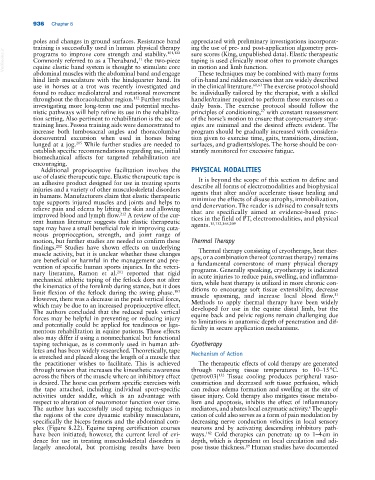Page 970 - Adams and Stashak's Lameness in Horses, 7th Edition
P. 970
936 Chapter 8
poles and changes in ground surfaces. Resistance band appreciated with preliminary investigations incorporat-
training is successfully used in human physical therapy ing the use of pre‐ and post‐application algometry pres-
VetBooks.ir Commonly referred to as a Theraband, the two‐piece taping is used clinically most often to promote changes
sure scores (King, unpublished data). Elastic therapeutic
programs to improve core strength and stability.
101,122
11
in motion and limb function.
equine elastic band system is thought to stimulate core
abdominal muscles with the abdominal band and engage These techniques may be combined with many forms
hind limb musculature with the hindquarter band. Its of in‐hand and ridden exercises that are widely described
use in horses at a trot was recently investigated and in the clinical literature. 60,63 The exercise protocol should
found to reduce mediolateral and rotational movement be individually tailored by the therapist, with a skilled
throughout the thoracolumbar region. Further studies handler/trainer required to perform these exercises on a
152
investigating more long‐term use and potential mecha- daily basis. The exercise protocol should follow the
27
nistic pathways will help refine its use in the rehabilita- principles of conditioning, with constant reassessment
tion setting. Also pertinent to rehabilitation is the use of of the horse’s motion to ensure that compensatory strat-
training lines. Pessoa training aids were demonstrated to egies are minimal and the desired effects evident. The
increase both lumbosacral angles and thoracolumbar program should be gradually increased with considera-
dorsoventral excursion when used in horses being tion given to exercise time, gaits, transitions, direction,
lunged at a jog. While further studies are needed to surfaces, and gradients/slopes. The horse should be con-
205
establish specific recommendations regarding use, initial stantly monitored for excessive fatigue.
biomechanical affects for targeted rehabilitation are
encouraging.
Additional proprioceptive facilitation involves the PHYSICAL MODALITIES
use of elastic therapeutic tape. Elastic therapeutic tape is It is beyond the scope of this section to define and
an adhesive product designed for use in treating sports
injuries and a variety of other musculoskeletal disorders describe all forms of electromodalities and biophysical
agents that alter and/or accelerate tissue healing and
in humans. Manufacturers claim that elastic therapeutic
tape supports injured muscles and joints and helps to minimize the effects of disuse atrophy, immobilization,
and denervation. The reader is advised to consult texts
relieve pain and edema by lifting the skin and allowing
improved blood and lymph flow. A review of the cur- that are specifically aimed at evidence‐based prac-
212
tices in the field of PT, electromodalities, and physical
rent human literature suggests that elastic therapeutic 15,132,166,209
tape may have a small beneficial role in improving cuta- agents.
neous proprioception, strength, and joint range of
motion, but further studies are needed to confirm these Thermal Therapy
findings. Studies have shown effects on underlying
212
Thermal therapy consisting of cryotherapy, heat ther-
muscle activity, but it is unclear whether these changes apy, or a combination thereof (contrast therapy) remains
are beneficial or harmful in the management and pre-
vention of specific human sports injuries. In the veteri- a fundamental cornerstone of many physical therapy
programs. Generally speaking, cryotherapy is indicated
nary literature, Ramon et al. reported that rigid
201
mechanical athletic taping of the fetlock does not alter in acute injuries to reduce pain, swelling, and inflamma-
tion, while heat therapy is utilized in more chronic con-
the kinematics of the forelimb during stance, but it does
183
limit flexion of the fetlock during the swing phase. ditions to encourage soft tissue extensibility, decrease
muscle spasming, and increase local blood flow.
11
However, there was a decrease in the peak vertical force,
which may be due to an increased proprioceptive effect. Methods to apply thermal therapy have been widely
developed for use in the equine distal limb, but the
The authors concluded that the reduced peak vertical
forces may be helpful in preventing or reducing injury equine back and pelvic regions remain challenging due
to limitations in anatomic depth of penetration and dif-
and potentially could be applied for tendinous or liga-
mentous rehabilitation in equine patients. These effects ficulty in secure application mechanisms.
also may differ if using a nonmechanical but functional
taping technique, as is commonly used in human ath- Cryotherapy
letes and has been widely researched. Theoretically, tape
is stretched and placed along the length of a muscle that Mechanism of Action
the practitioner wishes to facilitate. This is achieved The therapeutic effects of cold therapy are generated
through tension that increases the kinesthetic awareness through reducing tissue temperatures to 10–15 °C.
across the fibers of the muscle where an inhibitory effect (petrov03) Tissue cooling produces peripheral vaso-
152
is desired. The horse can perform specific exercises with constriction and decreased soft tissue perfusion, which
the tape attached, including individual sport‐specific can reduce edema formation and swelling at the site of
activities under saddle, which is an advantage with tissue injury. Cold therapy also mitigates tissue metabo-
respect to alteration of neuromotor function over time. lism and apoptosis, inhibits the effect of inflammatory
6
The author has successfully used taping techniques in mediators, and abates local enzymatic activity. The appli-
the regions of the core dynamic stability musculature, cation of cold also serves as a form of pain modulation by
specifically the biceps femoris and the abdominal com- decreasing nerve conduction velocities in local sensory
plex (Figure 8.22). Equine taping certification courses neurons and by activating descending inhibitory path-
have been initiated; however, the current level of evi- ways. Cold therapies can penetrate up to 1–4 cm in
182
dence for use in treating musculoskeletal disorders is depth, which is dependent on local circulation and adi-
largely anecdotal, but promising results have been pose tissue thickness. Human studies have documented
19

